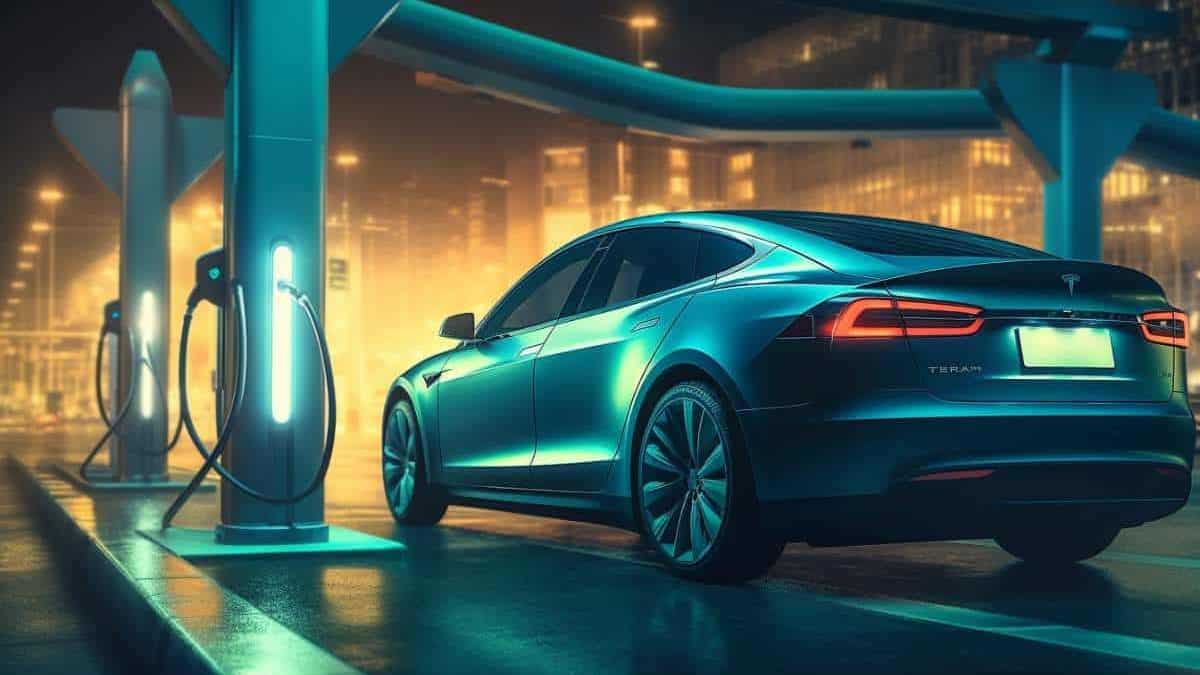Ever ponder the percentage of vehicles on our roads that produce zero emissions? I’ve often questioned this myself, particularly considering the worrisome fact that road transport accounts for about one-sixth of global emissions.
This blog dives into the realm of zero-emission vehicles worldwide, highlighting their importance in our clean energy transition and exploring recent trends and predictions. Ready to electrify your knowledge? Let’s get started!

Key Takeaways
- Zero emission vehicles are important for reducing environmental pollution and transitioning to clean energy.
- Electric car sales have been steadily increasing worldwide, with Europe leading the way in adoption rates.
- Regional differences exist in terms of zero – emission vehicle percentages, with Europe and China having high adoption rates while developing countries lag behind due to cost and infrastructure challenges.
- Sales of zero emission vehicles are projected to grow significantly in the coming years, driven by increasing demand, advancements in technology, and supportive government policies.
The Importance of Zero Emission Vehicles
Zero emission vehicles play a crucial role in the clean energy transition and have a significant impact on reducing environmental pollution.
Role in Clean Energy Transition
Zero-emission cars help us make clean energy a big part of our lives. They are key to cleaner roads without all the bad air from gas cars. Even better, they stop about one-sixth of the world’s dirty air from ever being made.
This matters because a lot of that bad air comes from gas cars and trucks on our roads now. In just ten years, these new kinds of cars could save us 5 million barrels of oil each day! That’s good for our planet and good for us too!
Environmental Impact
Cars that run on gas hurt our air. They make a lot of CO2 emissions. Electric vehicles help to clean the air. They don’t have an exhaust pipe, so they don’t pollute the air. This is good for everyone’s health and it helps stop global warming too.
One out of six parts of all world pollution comes from cars and trucks that use gas or diesel fuel. Switching to electric cars can reduce this number by a lot. But not many people in poor countries are buying electric cars yet because they cost too much money upfront and there aren’t enough places to charge them up.
Current State of Zero Emission Vehicles Worldwide

Electric car sales and market share have been steadily increasing worldwide, with Europe leading the way in electrification efforts. Regional differences exist in terms of adoption rates and infrastructure development, but overall, there’s a positive trend towards zero emission vehicles globally.
The rise of electric cars has been remarkable in recent years, as evidenced by their sales and market share. In 2022, electric car sales exceeded 10 million, representing a 14% share of total car sales. This trend continued in the first quarter of 2023, with over 2.3 million electric cars sold, marking a 25% increase compared to the same period the previous year. More impressively, it is projected that by the end of 2023, there will be 14 million electric car sales, indicating a 35% year-on-year increase.
| Year | Electric Car Sales (Millions) | Sales Share (%) |
|---|---|---|
| 2022 | 10 | 14 |
| Q1 2023 | 2.3 | 25 |
| End of 2023 (Projected) | 14 | 35 |
These figures demonstrate the growing acceptance and adoption of electric vehicles worldwide. They reflect the transformative shift in the automobile industry, driven by efforts toward achieving sustainability and reducing carbon emissions. As policies continue to support the shift to clean energy, the growth trajectory of electric vehicles is expected to increase.
Regional Highlights and Differences
Electric vehicle (EV) adoption varies significantly across different regions due to various factors, including government policies, economic status, infrastructure, and cultural attitudes. Here’s a glimpse at the percentage of vehicles that are zero-emission in selected regions.
| Region | Zero-Emission Vehicle Percentage | Key Factors |
|---|---|---|
| Europe | High | Europe, especially countries like Norway and The Netherlands, has been quick to adopt EVs. Government policies, incentives, and well-developed charging infrastructure drive this surge. |
| China | High | China’s EV market is thriving because of aggressive government policies pushing for cleaner transport options, massive investment in charging infrastructure, and domestic production of EVs. |
| United States (specific states) | Moderate to High | In the U.S., states like California and Oregon have higher EV adoption rates due to state-level policies, incentives, and growing charging infrastructure. |
| Emerging Countries | Low | Developing and emerging countries lag behind in EV adoption. High purchase costs and insufficient charging infrastructure are the primary barriers. |
It’s clear to see how regional factors significantly influence the adoption rate of zero-emission vehicles.
Future Predictions for Zero Emission Vehicles

Sales of zero emission vehicles are projected to experience significant growth in the coming years, fueled by increasing demand, advancements in technology, and supportive government policies.
Sales Projections and Growth Potential
In the future, the number of electric cars being sold is expected to keep growing. By the end of 2023, it’s predicted that there will be 14 million electric car sales, which is a 35% increase compared to the previous year.
Electric cars could also make up around 18% of all car sales in 2023. These projections show that more and more people are choosing electric vehicles as a greener alternative to traditional cars.
With these promising numbers, it’s clear that the growth potential for zero-emission vehicles is strong and they will continue to play an important role in reducing global emissions and transitioning to cleaner energy sources.
Infrastructure Developments
Infrastructure developments play a crucial role in the future of zero emission vehicles worldwide. The availability of charging infrastructure is essential for the widespread adoption of electric vehicles.
Currently, there are concerns about a lack of charging points, especially in developing and emerging countries. Limited access to chargers can discourage potential buyers from choosing electric cars due to range anxiety.
To accelerate the transition to zero emission transportation, it is important for governments and private sector entities to invest in expanding the network of public charging stations.
This will not only encourage more people to switch to electric vehicles but also create new business opportunities and jobs in the renewable energy sector. In addition to public chargers, investments should be made in battery gigafactories and other infrastructure required for the production and distribution of EV batteries.
By creating a robust charging infrastructure, we can pave the way for an electrified future with cleaner air and reduced greenhouse gas emissions.
Policy and Investment in Zero Emission Technology

Government initiatives and legislation, along with private sector strategies and targets, play a crucial role in driving the adoption of zero emission technology worldwide.
Government Initiatives and Legislation
Government initiatives and legislation play a crucial role in promoting the growth of electric vehicle markets worldwide. Here are some important measures taken by governments:
- Stricter emissions standards: Governments have implemented stricter emissions standards on new gasoline- and diesel-fueled cars, encouraging consumers to adopt zero emission vehicles.
- Incentives and subsidies: Many governments offer financial incentives and subsidies to promote the purchase of electric vehicles, making them more affordable for consumers.
- Charging infrastructure development: Governments are investing in the development of charging infrastructure to support the widespread adoption of electric vehicles. This includes installing public charging points in cities and along highways.
- Zero-emission vehicle mandates: Some countries have introduced regulations mandating automakers to produce a certain percentage of zero-emission vehicles in their fleet. This encourages manufacturers to focus on electric vehicle production.
- Research and development funding: Governments provide funding for research and development in electric vehicle technology, battery manufacturing, and charging networks. This helps drive innovation and supports the growth of the industry.
- International collaboration: Governments participate in international collaborations, such as the Global Memorandum of Understanding (MoU), to share knowledge, best practices, and accelerate the adoption of zero-emission vehicles globally.
Private Sector Strategies and Targets
In the private sector, companies are developing strategies and targets to support the adoption of zero emission technology for vehicles. Here are some important initiatives and actions:
- Automakers like Ford and Volvo have committed to delivering breakthrough electric vehicles that are affordable and accessible to the masses.
- Many companies are investing in research and development to improve battery technology, increase energy density, and reduce costs. This includes exploring alternatives like sodium-ion batteries and lithium iron phosphate (LFP) batteries.
- To address charging infrastructure challenges, companies are working on expanding public charging networks and developing smart charging solutions that optimize electricity usage.
- Collaboration within the automotive supply chain is crucial for the transition towards zero emission vehicles. Companies are partnering with suppliers to ensure a steady supply of essential components like batteries, electric drives, transmissions, and engines.
- Some companies are also exploring hydrogen fuel-cell operated vehicles as an alternative to battery-powered electric vehicles. This technology has the potential to offer longer driving range and faster refueling times.
- Companies are actively engaging in sustainability initiatives by setting ambitious carbon emissions reduction targets across their entire operations, including vehicle manufacturing processes.
Conclusion
In conclusion, the percentage of zero emission vehicles worldwide is steadily increasing. Electric cars play a crucial role in reducing carbon emissions and transitioning to cleaner energy.
While there are challenges with cost and infrastructure in some countries, ambitious policies and investments are driving growth in the electric vehicle market. With projections showing significant sales increases in the coming years, we can expect more progress towards a greener future for transportation.
FAQs
1. What does “zero emission vehicles” mean?
Zero emission vehicles are vehicles that produce no harmful pollutants or greenhouse gas emissions during operation, such as electric cars powered by batteries or fuel cells.
2. How many zero emission vehicles are there worldwide?
The percentage of zero emission vehicles worldwide is relatively low and varies depending on the country and region. Currently, they make up a small fraction of the total number of vehicles on the road.
3. Why is it important to increase the percentage of zero emission vehicles?
Increasing the percentage of zero emission vehicles is crucial for reducing air pollution, combating climate change, and improving public health. They contribute to cleaner air quality and help reduce carbon dioxide emissions that contribute to global warming.
4. What are some challenges in increasing the adoption of zero-emission vehicles?
Some challenges in increasing the adoption of zero-emission vehicles include high upfront costs, limited charging infrastructure, range limitations for electric cars, and consumer awareness about their benefits.
- Tesla Charger Installation Cost (Home Setups) - March 1, 2024
- Tesla Phone Key Disconnected (Troubleshooting Guide and Quick Fixes) - March 1, 2024
- Tesla FSD 12 (Explained) - March 1, 2024